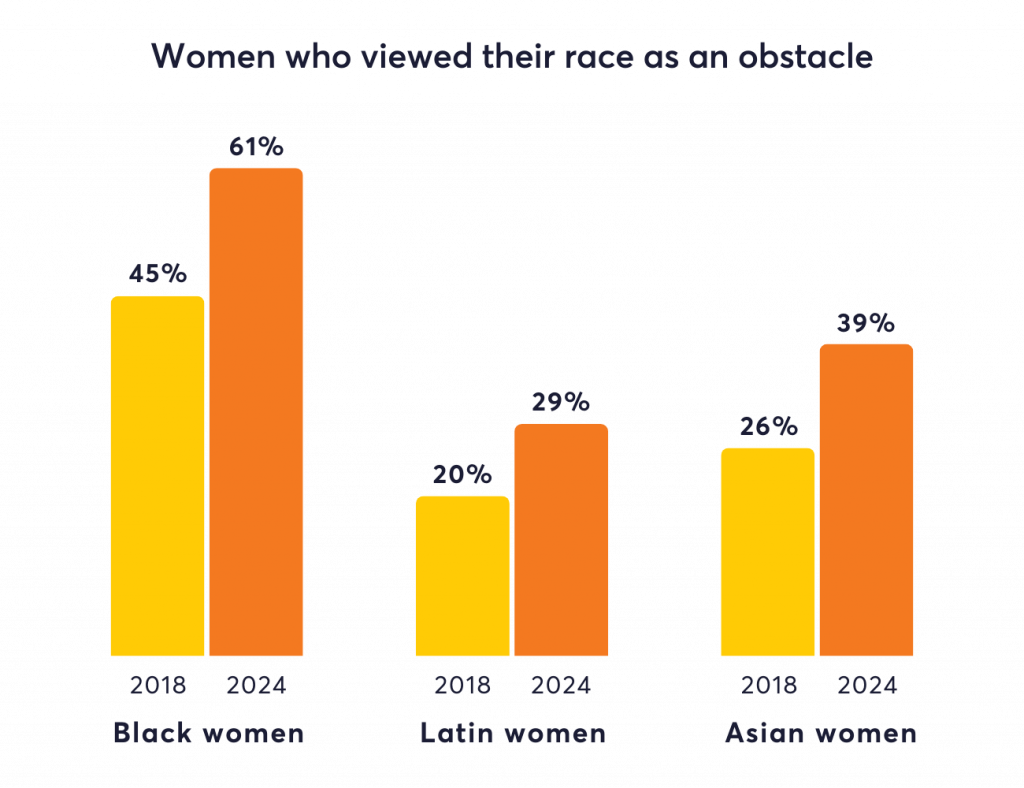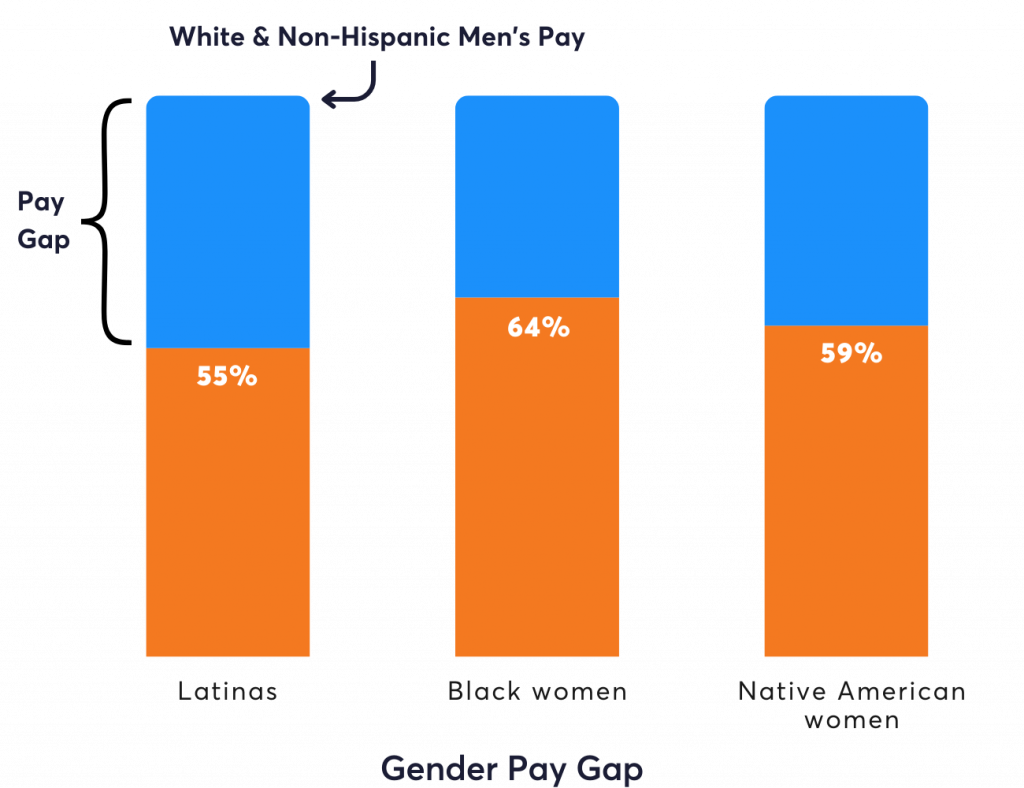
Women make up nearly half of the global workforce, contributing unique perspectives, talents, and innovations that fuel economic growth and drive business success. Yet, despite advances in gender equity, they continue to navigate workplaces shaped by deep-rooted disparities that impact their daily work lives. As women progress in their careers, they frequently encounter barriers that limit their full potential and impact.
For women in the workforce, the climb up the corporate ladder is hindered by challenges like underrepresentation in leadership, unequal pay, and discrimination. These hurdles impact their financial stability, career growth, and well-being. Studies show that women frequently prioritize inclusivity, collaboration, creativity, and compassion, which are valuable for driving innovation and navigating complex situations. When these obstacles persist—even unintentionally—businesses miss out on the unique talents and contributions that women bring. By acknowledging systemic challenges and actively working to dismantle them, organizations can unlock the full potential of a diverse and dynamic workforce.
Representation In Corporate Roles

The “broken rung” in the corporate pipeline is a well-documented issue, with fewer women—particularly women of color—advancing to their first managerial role compared to their male counterparts. This disparity has compounding effects, reducing the number of women eligible for senior leadership in the long term.
Additionally, women of color are less likely to receive support from their managers (e.g., help balancing work and personal life, assistance navigating organizational politics, recognition for their contributions, interest in their career advancement) than their white colleagues. This imbalance extends to mentorship and sponsorship, leaving them at a disadvantage when navigating workplace challenges and securing promotions. A lack of support contributes to why women of color, despite equal qualifications and ambition, are often overlooked for managerial roles and remain disproportionately represented at senior levels.
Key Research And Trends
- For every 100 men promoted to their first management position, only 89 white women and 81 women of color achieve the same promotion.
- Women hold 29% of C-suite roles in 2024, a rise from 17% in 2015. However, men continue to outnumber women at every level of the corporate pipeline.
- Only 7% of C-suite positions are held by women of color in 2024 (a four-percentage–point increase since 2017).
- Women hold 39% of managerial roles in 2024, a number that has seen little growth and even slight declines in recent years. The highest level of female managerial representation over the past decade was 41% in 2021.
- White women are projected to reach parity in corporate roles in about 22 years from 2024, and it will take more than twice as long (about 48 years) for women of color.
- More women of color today say their race/ethnicity has played a role in missing out on opportunities than in previous years: 61% of Black women in 2024 compared to 45% in 2018; 29% of Latinas in 2024 compared to 20% in 2018; and 39% of Asian women in 2024 compared to 26% in 2018.

To create a more equitable corporate pipeline, companies must address the systemic barriers that prevent women from advancing in their careers. Initiatives could include:
- Bias training in performance evaluations and hiring practices
- Greater transparency in promotion criteria and decision-making processes
- Structured mentorship and sponsorship for women of color
- Accountability mechanisms for diversity goals (e.g., setting measurable targets and reporting progress quarterly and annually)
Pay Disparities

Despite decades of awareness, gender-based pay disparities continue to impact women across industries and roles. Women still earn less than their male counterparts, compounded by pay gaps that grow with higher positions. These disparities affect their financial well-being, long-term career advancement, and retirement savings.
One factor perpetuating pay inequity is performance bias: women are often evaluated based on proven results, while men are promoted based on perceived potential. Additionally, women who negotiate salary increases tend to face more pushback or negative perceptions compared to men, who are generally rewarded for negotiating. These factors can discourage women from seeking equitable pay.
Key Research And Trends
- Women earn about 83 cents for every dollar men earn.
- Rural Black and Hispanic women earn 56 cents for every dollar made by rural white, non-Hispanic men.

- Latinas earn only 55% of what non-Hispanic white men are paid.
- Black women are paid 64% of the wages of non-Hispanic white men.
- Native American women earn only 59 cents for every dollar earned by white, non-Hispanic men.
- It will take an estimated 132 years to close the global gender pay gap at the current rate of change in 2024.
- A 20-year-old woman starting full-time work in 2024 stands to lose $407,760 over a 40-year career compared to her male counterpart.
To ensure fair and equitable compensation, companies must address ongoing pay disparities through:
- Regular pay audits
- Clear pay bands and salary structures for positions
- Manager training on pay transparency and communication
Microaggressions

Microaggressions—subtle, often unintentional comments or behaviors that reinforce stereotypes—disproportionately affect women. These interactions can range from assumptions about capabilities based on gender or race to comments that question women’s authority.
Over time, these interactions erode confidence, decrease engagement, and contribute to a hostile work environment. Those who regularly experience microaggressions are more likely to leave their jobs due to experiencing consistent stress and feeling undervalued.
Key Research And Trends
- Thirty-eight percent of women have had their judgment questioned in their area of expertise, compared to 26% of men.
- Eighteen percent of women have been mistaken for someone at a much lower level than they are, compared to 10% of men.
- Thirty-nine percent of women have been interrupted or spoken over more than others, compared to 20% of men.
- More than one in four LGBTQ+ women feel like they can’t talk about their personal lives at work. This is largely due to “othering” microaggressions (subtle put-downs about a person’s perceived marginalized status), which LGBTQ+ women and women with disabilities report experiencing at the highest rates.
- Twenty-eight percent of women recognize microaggressions against other women, compared to 11% of men.
- Forty-nine percent of women under 30 believe their age has negatively impacted them at work, and they are more than twice as likely to field ageist comments than men (22% and 12%, respectively).
To foster an inclusive, respectful, and psychologically safe environment, organizations must recognize and address microaggressions. This can be supported through:
- DEI and bias training
- Clear anti-discrimination policies
- Safe channels for employees to report microaggressions
- Training on handling difficult conversations at work to confront microaggressions in real time
Benefits And Work-Life Balance

In recent years, organizations have expanded benefits to support workers with caregiving responsibilities, including paid maternity leave, paternity leave, and childcare services. These benefits are especially important for women, who continue to bear the majority of family caregiving duties.
The rise of flexible work arrangements, including remote and hybrid options, marks another major shift. For many women, particularly those balancing work and family roles, remote work has been foundational for sustaining productivity and well-being.
However, even as flexible work policies grow, women often face stigma or bias for using them. This can lead to career setbacks, such as missed promotions or slower advancement, as flexible work or extended leave may be perceived as a lack of commitment.
Key Research And Trends
- Twenty-seven percent of private-sector workers in the US have access to paid family leave, while 72% of the largest 500 public US companies provide some amount of paid parental leave.
- Forty percent of women say they shoulder most or all housework in 2024—the same as in 2016—despite 75% of men saying they share housework equally with their partner.
- Half of companies provide emergency childcare services in 2024, up from 33% in 2016.
- Eighty percent of organizations offer benefits for fertility treatments and adoption or surrogacy.
- Eighty percent of employees say flexibility has improved in the last decade; however, one in three employees saw a decline in flexibility in 2024.
- Women are more likely to express a need for flexible work options, citing remote arrangements as a primary factor in maintaining their focus, productivity, and well-being.
To drive real progress, companies must foster work-life balance by implementing supportive policies and addressing any biases that deter their use. Key initiatives include:
- Family-friendly policies (e.g., maternity and paternity leave, childcare)
- Flexible work arrangements
- Return-to-work programs for employees returning from extended leave
- Frequent promotion of benefits encouraging their use to reduce stigma
Conclusion

The path to a truly equitable workplace requires commitment, intentionality, and accountability from organizations. By fostering inclusive policies and addressing pervasive barriers, companies can support women in the workplace and create a culture of trust and allyship. As businesses strive to close gaps in representation, pay, and support systems, they are setting a foundation for a future where gender and race no longer define the trajectory of one’s career.












